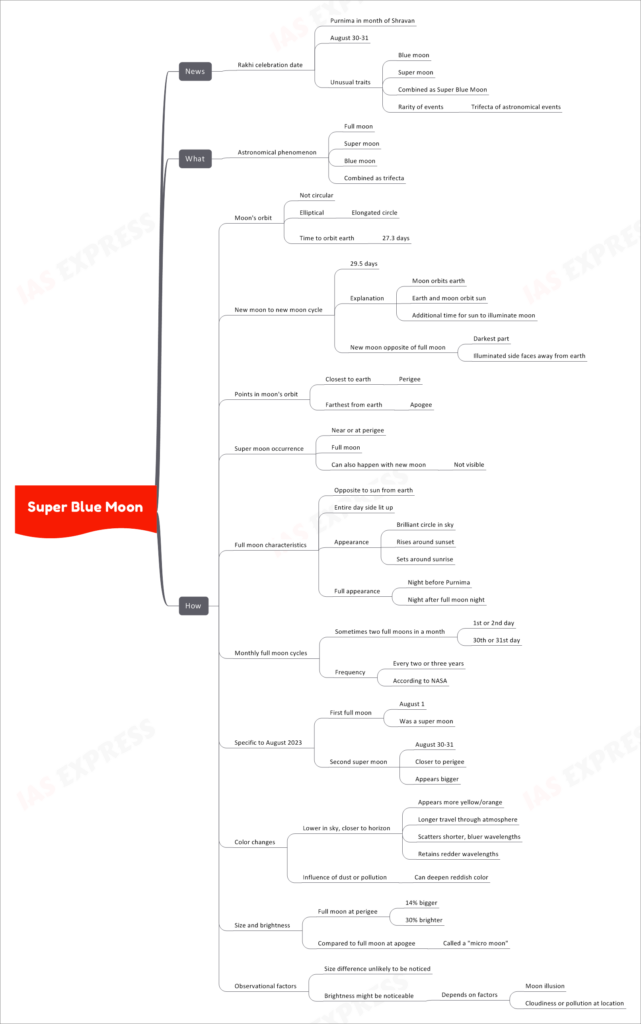Super Blue Moon

The date of Rakhi celebration holds a special place in the month of Shravan, falling on August 30-31. This year, the Rakhi festivities are accompanied by a celestial spectacle known as the Super Blue Moon, a trifecta of unique astronomical events that combine to create a captivating and rare phenomenon.
Understanding the Phenomenon
- Intricate Combination: The Super Blue Moon is a distinctive amalgamation of three extraordinary lunar occurrences – a full moon, a super moon, and a blue moon.
The Moon’s Orbit
- The Orbit’s Nature: The moon’s orbit around the Earth is not a perfect circle; it is elliptical, resembling a slightly elongated circle.
- Duration of Orbit: The moon takes approximately 27.3 days to complete one orbit around the Earth.
Decoding the Lunar Cycle
- New Moon to New Moon: The lunar cycle spans about 29.5 days, during which the moon orbits the Earth and the Earth orbits the Sun.
- The Explanation: The additional time taken for the Sun’s illumination to reach the moon causes the appearance of the moon to change over this cycle.
- Opposite Phases: The new moon, the opposite phase of the full moon, presents the darkest side, with the illuminated face turned away from Earth.
Key Points in the Moon’s Journey
- Closest Proximity: The point in the moon’s orbit closest to the Earth is called the perigee.
- Farthest Reach: The farthest point from Earth is known as the apogee.
Unveiling the Super Moon
- Super Moon’s Occurrence: A super moon occurs when the moon is at or near its perigee during a full moon.
- Not Limited to Full Moons: The super moon phenomenon can also take place during a new moon, although it remains invisible from our vantage point.
The Characteristics of the Full Moon
- Positioning Opposite to the Sun: A full moon occurs when the moon is positioned opposite to the Sun as observed from Earth.
- Illumination of the Entire Day Side: The full moon lights up the entirety of its day side.
- Striking Appearance: It presents a brilliant circular appearance in the night sky, rising around sunset and setting around sunrise.
- Full Appearance Beyond Purnima: The full moon is visible on the night before Purnima and the night after the full moon night.
Monthly Variations and Uncommon Occurrences
- Occasional Dual Full Moons: Sometimes, two full moons occur within a single month, typically on the 1st or 2nd day and the 30th or 31st day.
- Frequency: Such instances, termed blue moons, happen every two to three years, according to NASA.
- August 2023’s Uniqueness: The year 2023 witnessed a distinctive August, with two super moons – one on August 1 and another on August 30-31, which is closer to the perigee, appearing larger in the sky.
Unveiling Color Changes and Size-Brightness Variations
- Shifting Colors: When the moon is lower in the sky, closer to the horizon, it appears more yellow or orange due to longer travel through the Earth’s atmosphere.
- Influence of Dust and Pollution: Dust or pollution can intensify this reddish hue.
- Size and Brightness: A full moon at perigee appears approximately 14% bigger and shines about 30% brighter than its counterpart at apogee, which is called a “micro moon.”
Observational Nuances
- Size Perception: The difference in size between the two moon positions is unlikely to be distinctly noticeable to the naked eye.
- Brightness Observation: The brightness might be more noticeable, contingent on factors like the moon illusion, cloudiness, or pollution at a specific location.
If you like this post, please share your feedback in the comments section below so that we will upload more posts like this.

